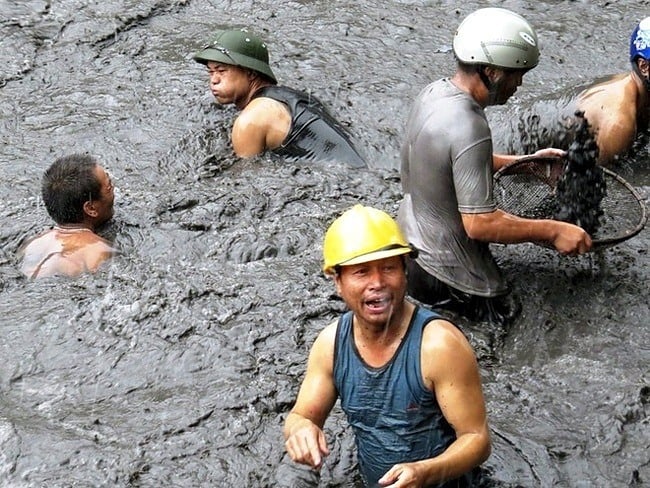Extreme weather event unfolds further in Vietnam with toxic spills and flooding now from multiple coal mine and power plant sites surrounding Ha Long Bay
By: Waterkeeper Alliance

Quang Ninh, Vietnam – August 1, 2015: Ongoing and forecast increased downpours in northeastern Vietnam have now seen toxic spills and flooding from multiple coal mine and power plant sites in the province surrounding the Ha Long Bay World Heritage Site.
“The likelihood of both immediate and ongoing health and environmental hazards for locals and the rare environment there are clearly increasing by the hour and the scale of this event cannot be understated,” said Ms. Donna Lisenby, Clean and Safe Energy Campaign Manager for Waterkeeper Alliance.
The events of the last few days appear to be getting worse with news reports of severe flooding inundating the Lang Khanh harbor area and Dien Vong river with fresh leakages from the Quang Ninh coal-fired power plant. This coal plant is located on the waterfront that connects directly to world renowned Ha Long Bay world heritage site (see this map).
“A disaster response team from the government has been deployed which is encouraging but we are deeply concerned by the pace of this unfolding disaster and its sheer scale,” said Robert F. Kennedy, Jr, President of Waterkeeper Alliance.
Ha Long Bay is surrounded by 5,736 hectares of open pit coal mines and 3 coal fired power plants. They are already flooded with more rain predicted for the next 7 days. “We again urge the Government and encourage UNESCO, and the international community to get involved and protect Ha Long Bay from further pollution by coal mines and coal-fired power plants,” said Mr. Kennedy. “We need to see all parties acting decisively to protect the growing number of local communities and this pristine World Heritage Site that are facing clear and present danger.”
“Waterkeeper Alliance knows from first hand experience around the world that coal mining and generation sites are ‘monster waste generators’ of the worst kind,” said Ms. Lisenby. “These coal waste facilities are ticking time bombs if they are not properly constructed to withstand large rainfall events, which are already increasing in frequency, duration and intensity in line with climate science predictions,” said Ms. Lisenby.
The coal industry generates massive amounts of waste that can contain a wide array of materials dangerous to human health and the environment including heavy metals like arsenic, boron, barium, cadmium, chromium, lead, manganese, selenium and thallium.
Dr. Aaron Bernstein, Instructor in Pediatrics at Harvard University Medical School said, “Floodwaters flowing from open pit coal mines likely contain a slurry of toxic heavy metals, including arsenic, cadmium and lead, as well as other harmful substances. We also know from past research that the soils in this region of Vietnam may be contaminated with these same pollutants, which may be mobilized by floods as we saw in New Orleans after Hurricane Katrina. So, in addition to the usual harms that may immediately follow severe flooding such as traumatic injuries, outbreaks of waterborne disease, or death, the floods around Quang Ninh carry the potential to exact permanent damage to the developing nervous systems of children which are uniquely vulnerable to these toxic elements. ”
Cam Pha City has already been flooded with an avalanche of coal mining waste and a second community is being evacuated (see map here). News photos and video footage from Cam Pha show men, women and children wading through thick mud contaminated with coal waste as they flee their homes.
Media Contacts:
Tina Posterli [email protected] +1-516-526-9371 (US)
Andrew Bradley [email protected] +61 403 777 137 (Australia)
Waterkeeper Alliance has experienced a dramatic rise in the number of coal-related water spill disasters we have responded to since 2008. These include:
1) The largest known coal ash waste spill in world history in December of 2008 from the Tennessee Valley Authority coal plant in Kingston, TN. See this story for an interview with Donna Lisenby, Waterkeeper Alliance’s Clean & Safe Energy Campaign manger who was the first person to collect samples at the spill proving that it contaminated the Emory river with toxic heavy metals.
2) The largest coal slurry spill in Canadian history on Halloween night in 2013. See stories here, here and here written by Waterkeeper Alliance Clean Safe Energy Campaign Manager.
3) A January 2014 coal chemical spill into the Elk River in West Virginia that poisoned the drinking water of 300,000 people. See story here.
4) The largest coal ash spill in NC history by Duke Energy into the Dan River in February of 2014. See stories here, here, here and here that document Waterkeeper Alliance’s response to that spill and all the toxins found as a result of our water testing. The Dan River spill and ongoing investigation by Waterkeeper Alliance into illegal coal water pollution by Duke Energy at other sites in NC resulted in their criminal conviction for nine clean water act violations.
5) This is a story about how WKA responds when disasters like these strike.
Photo credit: Vietnamnet – Ignoring the hazard warning from the local government, hundreds of people who regretted the “black gold” drifting out to sea sought every way to salvage coal.